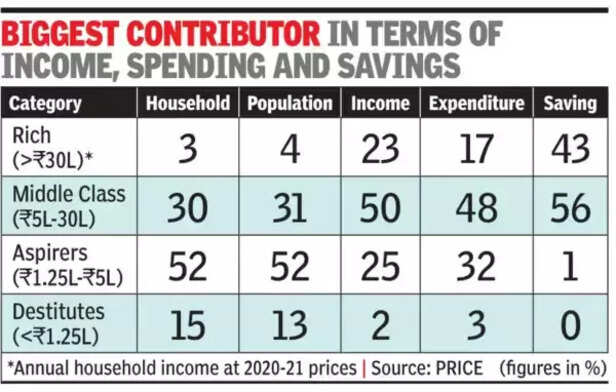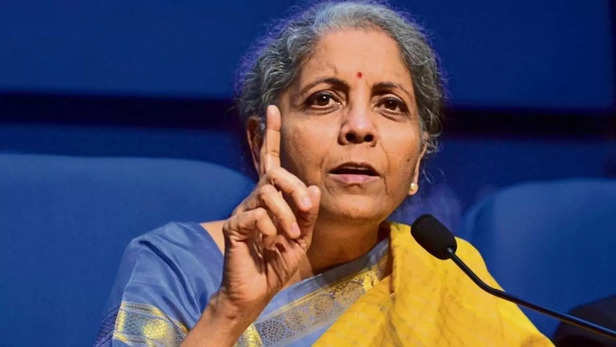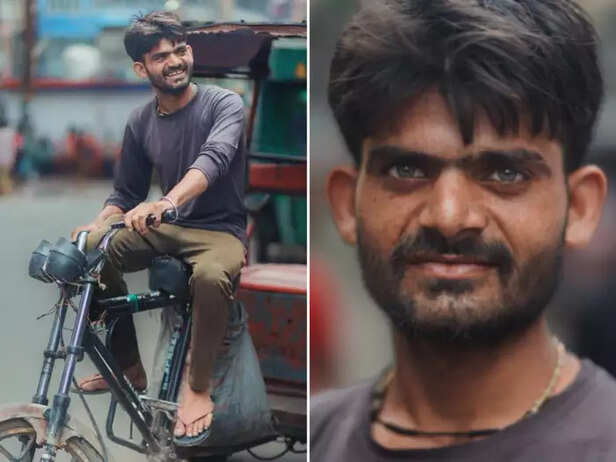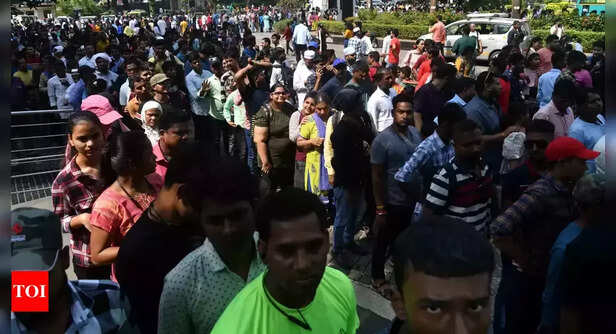Is Life Truly Unfair, or Is the Middle Class Trapped in a System of Inequality?
Nidhi | Jan 28, 2025, 20:27 IST
( Image credit : Timeslife )
India’s middle class is caught in a heartbreaking struggle between survival and aspiration. Despite being the backbone of the economy, they face crushing challenges—high taxes, stagnant incomes, and skyrocketing costs—leaving little room for dreams beyond basic necessities. This article sheds light on their daily battles, highlighting real-life stories, emotional sacrifices, and systemic barriers that keep them trapped in a cycle of unfulfilled potential. With compelling data and heartfelt narratives, it calls for urgent reforms to ease their burden and give voice to a segment that silently fuels the nation’s growth yet remains unseen and unheard.
“Dreams are not luxuries; they are the pulse of existence. Yet, for India's middle class, dreams often feel like whispers of a life they may never live.”
In a country celebrated for its vibrant growth story, the middle class—the very backbone of this progress—finds itself ensnared in a paradox. They are neither poor enough to deserve government aid nor wealthy enough to escape the relentless grind. This article delves into their haunting reality: a life of unending struggle, where aspirations are constantly overshadowed by an unforgiving economic system.

India’s middle class, encompassing around 30% of the population (approximately 440 million people), plays a critical role in the nation’s economy. They contribute significantly to the GDP through consumption and taxation, yet they remain trapped in an endless cycle of "earn-pay-survive."
The per capita income in India stands at ₹1.96 lakh per annum (2023), a figure that starkly contrasts with the aspirations of the average middle-class family. Most middle-class professionals earn between ₹6 lakh and ₹36 lakh annually, but even at the upper end of this spectrum, high taxes and rising inflation devour their earnings.

India’s tax system is one of the harshest for the salaried middle class. An individual earning ₹20 lakh annually ends up paying over ₹5 lakh in income tax—more than 25% of their earnings. Factor in indirect taxes like GST, fuel taxes, and tolls, and the financial burden grows exponentially. According to government data, indirect taxes account for 65% of India’s tax revenue. This regressive taxation disproportionately affects the middle class, squeezing them dry while leaving little room for saving or investment.
“We carry the economy on our backs, yet our dreams are taxed to extinction,” laments Nidhi Sharma, a schoolteacher from Delhi. “Every time I think of upgrading my home or saving for my son’s education, another expense or tax takes away that possibility.”

For the Indian middle class, life revolves around fulfilling basic needs. Rent or EMIs, groceries, utility bills, children's education, and medical expenses consume a lion’s share of their income. By the end of the month, there’s barely anything left to save or invest in fulfilling long-cherished aspirations.
Inflation adds salt to their wounds. The cost of living has risen steeply—education, healthcare, and even daily essentials have become luxuries for many. For instance, private school education in metropolitan cities costs anywhere between ₹1 lakh and ₹5 lakh annually per child, while healthcare expenses, even for minor ailments, can set families back by tens of thousands.
“Our dreams are drowned in the bills we pay,” says Ravi Prakash, an IT professional from Bengaluru. “The house I want to buy seems further away every year. The more I earn, the less I seem to have.”

Beyond numbers, the middle class suffers in ways that statistics cannot capture. Aspirations—a cornerstone of middle-class identity—remain perpetually postponed. Be it buying a house, pursuing higher education, or even taking a modest vacation, these dreams fade into the background as families grapple with survival.
The mental toll is equally severe. Studies reveal that financial stress is one of the leading causes of anxiety and depression in middle-class households. The pressure to maintain a "respectable" standard of living, coupled with societal expectations, often results in emotional burnout.
“I dreamt of sending my daughter to an Ivy League college, but even thinking about it now feels cruel,” shares Ritu Mishra, a marketing executive. “I don’t want her to bear the same struggles I do, yet I can’t seem to break free from them.”

The challenges of the middle class are not accidental; they stem from a deeply entrenched hierarchy within India's economic framework. Subsidies and benefits often bypass them entirely, targeted instead at the economically weaker sections. Meanwhile, the wealthiest benefit from loopholes, tax breaks, and policies that favor corporate entities.
Despite their significant contribution to the economy, the middle class remains largely ignored in policy-making. Even when relief measures are announced, they are often tokenistic, providing little tangible benefit. Finance Minister Nirmala Sitharaman’s assurance, “We are a government that listens,” often rings hollow for those who feel left behind.
 '
'
The plight of the middle class raises pressing questions: How can a nation that depends so heavily on this group fail to support them adequately? Can systemic reforms provide the much-needed relief?
Some solutions seem obvious. Reducing the tax burden by increasing the income tax exemption limit or lowering GST rates on essentials would provide immediate relief. Expanding government subsidies for education and healthcare could ease financial pressures significantly. Most importantly, a shift toward progressive taxation—where the wealthy contribute a fairer share—would create a more balanced system.
The middle class is not asking for luxury or privilege. Their dreams are simple: a secure home, quality education for their children, access to healthcare, and the dignity of financial stability. Yet, in today’s India, even these modest aspirations seem unattainable.
As you read this, millions of middle-class Indians are sitting at their desks, stuck in traffic, or standing in queues—silently enduring a system that demands everything but gives so little in return. Their voices, though muffled by the weight of their struggles, carry a profound message: Life may be unfair, but it doesn’t have to be this way.
In a country celebrated for its vibrant growth story, the middle class—the very backbone of this progress—finds itself ensnared in a paradox. They are neither poor enough to deserve government aid nor wealthy enough to escape the relentless grind. This article delves into their haunting reality: a life of unending struggle, where aspirations are constantly overshadowed by an unforgiving economic system.
The Numbers Tell a Grim Story

India's Middle Class
( Image credit : Timeslife )
India’s middle class, encompassing around 30% of the population (approximately 440 million people), plays a critical role in the nation’s economy. They contribute significantly to the GDP through consumption and taxation, yet they remain trapped in an endless cycle of "earn-pay-survive."
The per capita income in India stands at ₹1.96 lakh per annum (2023), a figure that starkly contrasts with the aspirations of the average middle-class family. Most middle-class professionals earn between ₹6 lakh and ₹36 lakh annually, but even at the upper end of this spectrum, high taxes and rising inflation devour their earnings.
Taxation: A Heavy Price for Hard Work

Nirmala Sitharaman
( Image credit : Timeslife )
India’s tax system is one of the harshest for the salaried middle class. An individual earning ₹20 lakh annually ends up paying over ₹5 lakh in income tax—more than 25% of their earnings. Factor in indirect taxes like GST, fuel taxes, and tolls, and the financial burden grows exponentially. According to government data, indirect taxes account for 65% of India’s tax revenue. This regressive taxation disproportionately affects the middle class, squeezing them dry while leaving little room for saving or investment.
“We carry the economy on our backs, yet our dreams are taxed to extinction,” laments Nidhi Sharma, a schoolteacher from Delhi. “Every time I think of upgrading my home or saving for my son’s education, another expense or tax takes away that possibility.”
The Vicious Cycle: Struggling to Stay Afloat

Purnai Delhi Rickshaw wala
( Image credit : Timeslife )
For the Indian middle class, life revolves around fulfilling basic needs. Rent or EMIs, groceries, utility bills, children's education, and medical expenses consume a lion’s share of their income. By the end of the month, there’s barely anything left to save or invest in fulfilling long-cherished aspirations.
Inflation adds salt to their wounds. The cost of living has risen steeply—education, healthcare, and even daily essentials have become luxuries for many. For instance, private school education in metropolitan cities costs anywhere between ₹1 lakh and ₹5 lakh annually per child, while healthcare expenses, even for minor ailments, can set families back by tens of thousands.
“Our dreams are drowned in the bills we pay,” says Ravi Prakash, an IT professional from Bengaluru. “The house I want to buy seems further away every year. The more I earn, the less I seem to have.”
Dreams Deferred: The Emotional Toll

Dreams of Middle Class
( Image credit : Timeslife )
Beyond numbers, the middle class suffers in ways that statistics cannot capture. Aspirations—a cornerstone of middle-class identity—remain perpetually postponed. Be it buying a house, pursuing higher education, or even taking a modest vacation, these dreams fade into the background as families grapple with survival.
The mental toll is equally severe. Studies reveal that financial stress is one of the leading causes of anxiety and depression in middle-class households. The pressure to maintain a "respectable" standard of living, coupled with societal expectations, often results in emotional burnout.
“I dreamt of sending my daughter to an Ivy League college, but even thinking about it now feels cruel,” shares Ritu Mishra, a marketing executive. “I don’t want her to bear the same struggles I do, yet I can’t seem to break free from them.”
Caught in the Hierarchy: A System Designed to Fail

Hustle Culture
( Image credit : Timeslife )
The challenges of the middle class are not accidental; they stem from a deeply entrenched hierarchy within India's economic framework. Subsidies and benefits often bypass them entirely, targeted instead at the economically weaker sections. Meanwhile, the wealthiest benefit from loopholes, tax breaks, and policies that favor corporate entities.
Despite their significant contribution to the economy, the middle class remains largely ignored in policy-making. Even when relief measures are announced, they are often tokenistic, providing little tangible benefit. Finance Minister Nirmala Sitharaman’s assurance, “We are a government that listens,” often rings hollow for those who feel left behind.
Breaking Free: Is There Hope for the Middle Class?

Middle Class's Struggle
( Image credit : Timeslife )
The plight of the middle class raises pressing questions: How can a nation that depends so heavily on this group fail to support them adequately? Can systemic reforms provide the much-needed relief?
Some solutions seem obvious. Reducing the tax burden by increasing the income tax exemption limit or lowering GST rates on essentials would provide immediate relief. Expanding government subsidies for education and healthcare could ease financial pressures significantly. Most importantly, a shift toward progressive taxation—where the wealthy contribute a fairer share—would create a more balanced system.
A Reflection of Drowning Aspirations
As you read this, millions of middle-class Indians are sitting at their desks, stuck in traffic, or standing in queues—silently enduring a system that demands everything but gives so little in return. Their voices, though muffled by the weight of their struggles, carry a profound message: Life may be unfair, but it doesn’t have to be this way.
